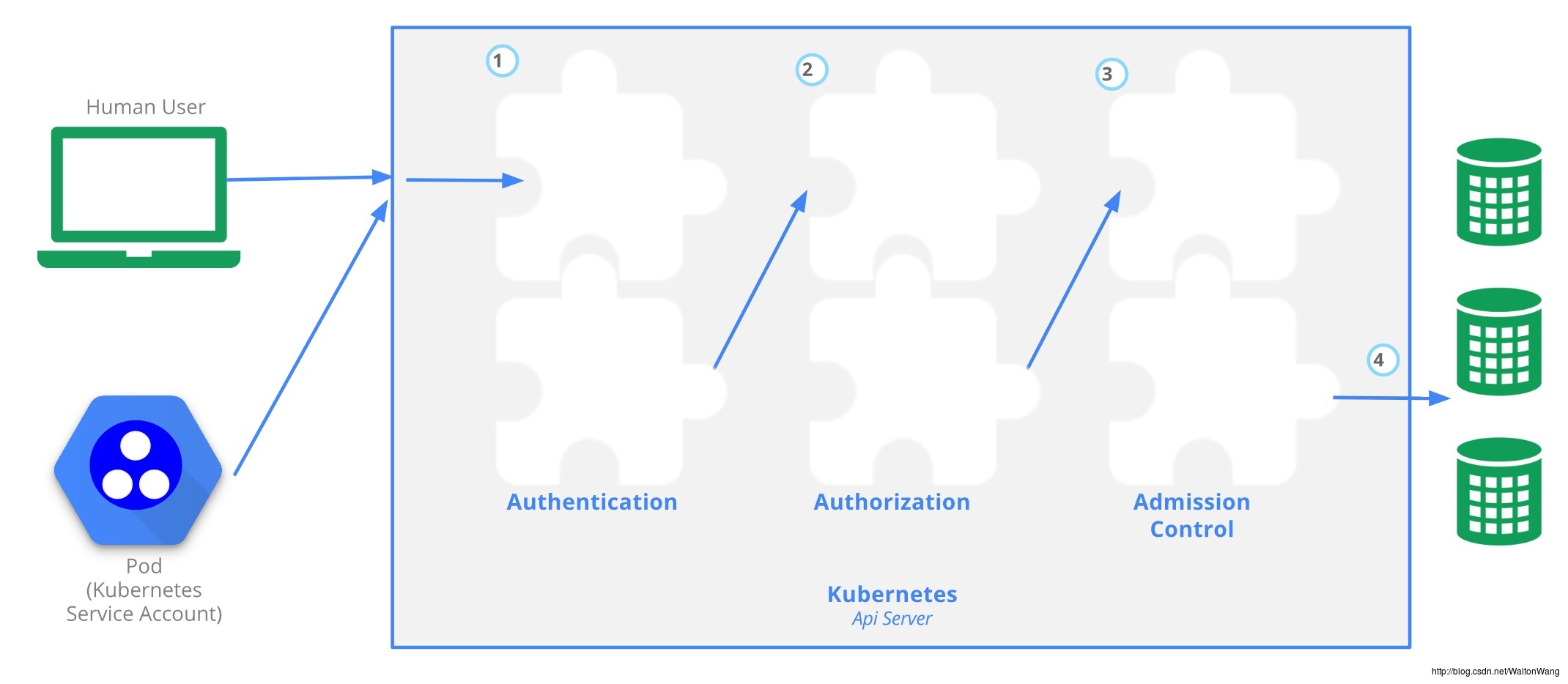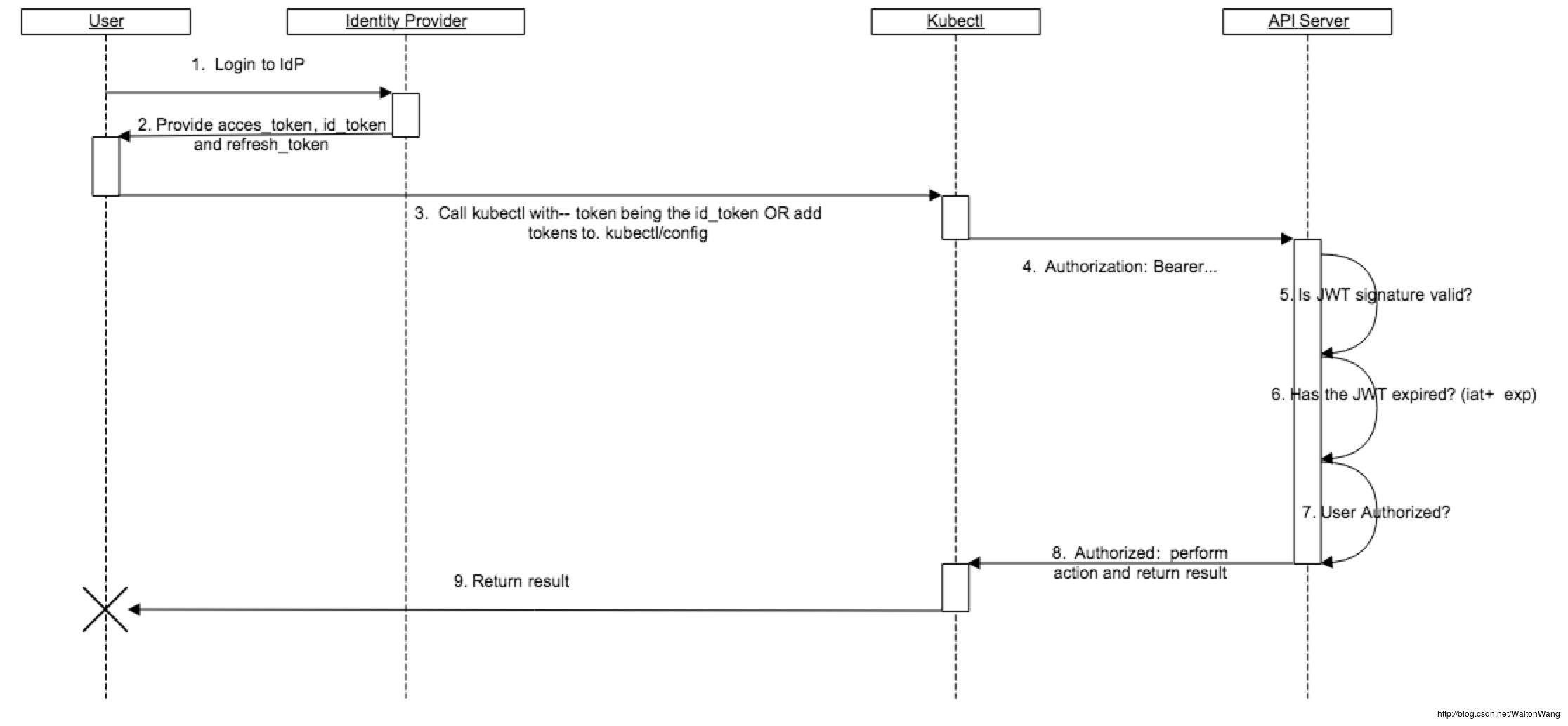Controlling Access to the Kubernetes API
Posted WaltonWang
tags:
篇首语:本文由小常识网(cha138.com)小编为大家整理,主要介绍了Controlling Access to the Kubernetes API相关的知识,希望对你有一定的参考价值。
更多关于kubernetes的深入文章,请看我csdn或者oschina的博客主页。

API Server Ports and IPs
By default the Kubernetes API server serves HTTP on 2 ports:
Localhost Port:
- is intended for testing and bootstrap, and for other components of the master node
(scheduler, controller-manager) to talk to the API - no TLS
- default is port 8080, change with
--insecure-portflag. - defaults IP is localhost, change with
--insecure-bind-addressflag. - request bypasses authentication and authorization modules.
- request handled by admission control module(s).
- protected by need to have host access
Secure Port:
- use whenever possible
- uses TLS. Set cert with
--tls-cert-fileand key with--tls-private-key-fileflag. - default is port 6443, change with
--secure-portflag. - default IP is first non-localhost network interface, change with
--bind-addressflag. - request handled by authentication and authorization modules.
- request handled by admission control module(s).
- authentication and authorisation modules run.
- is intended for testing and bootstrap, and for other components of the master node
Users in Kubernetes
All Kubernetes clusters have two categories of users: service accounts managed by Kubernetes, and normal users.
Kubernetes does not have objects which represent normal user accounts. Regular users cannot be added to a cluster through an API call.
In contrast, service accounts are users managed by the Kubernetes API.
API requests are tied to either a normal user or a service account, or are treated as anonymous requests.
Kubernetes Authenticating
Authentication strategies
Authentication modules include Client Certificates, Password, and Plain Tokens, Bootstrap Tokens, and JWT Tokens (used for service accounts).
Multiple authentication modules can be specified, in which case each one is tried in sequence, until one of them succeeds.
The API server does not guarantee the order authenticators run in.
The system:authenticated group is included in the list of groups for all authenticated users.
authentication plugins attempt to associate the following attributes with the request:
- Username
- UID
- Groups
- Extra fields
X509 Client Certs
- Client certificate authentication is enabled by passing the –client-ca-file=SOMEFILE option to API server.
--client-ca-file=/srv/kubernetes/ca.crt--tls-cert-file=/srv/kubernetes/server.crt--tls-private-key-file=/srv/kubernetes/server.keythe common name of the subject is used as the user name for the request.
For example, using the openssl command line tool to generate a certificate signing request:
openssl req -new -key jbeda.pem -out jbeda-csr.pem -subj “/CN=jbeda/O=app1/O=app2”
This would create a CSR for the username “jbeda”, belonging to two groups, “app1” and “app2”.
use openssl to manually generate certificates for your cluster.
- openssl genrsa -out ca.key 2048
- openssl req -x509 -new -nodes -key ca.key -subj “/CN=$MASTER_IP” -days 10000 -out ca.crt
- openssl genrsa -out server.key 2048
- openssl req -new -key server.key -subj “/CN=$MASTER_IP” -out server.csr
- openssl x509 -req -in server.csr -CA ca.crt -CAkey ca.key -CAcreateserial -out server.crt -days 10000
- openssl x509 -noout -text -in ./server.crt
Static Token File
- The API server reads bearer tokens from a file when given the
--token-auth-file=SOMEFILEoption on the command line. The token file is a csv file with a minimum of 3 columns: token, user name, user uid, followed by optional group names. For example,
token,user,uid,"group1,group2,group3"Putting a Bearer Token in a Request: Authorization header with a value of Bearer THETOKEN. For example,
Authorization: Bearer 31ada4fd-adec-460c-809a-9e56ceb75269
- The API server reads bearer tokens from a file when given the
Bootstrap Tokens
- This feature is currently in alpha.
--experimental-bootstrap-token-authflag on the API Server.- You must enable the TokenCleaner controller via the
--controllers=*,tokencleanerflag on the Controller Manager.
Static Password File
- Basic authentication is enabled by passing the
--basic-auth-file=SOMEFILEoption to API server. - The basic auth file is a csv file with a minimum of 3 columns: password, user name, user id.
- In Kubernetes version 1.6 and later, you can specify an optional fourth column containing comma-separated group names. For example:
password,user,uid,"group1,group2,group3" - When using basic authentication from an http client, the API server expects an Authorization header with a value of
Basic BASE64ENCODED(USER:PASSWORD).
- Basic authentication is enabled by passing the
Service Account Tokens
--service-account-key-fileA file containing a PEM encoded key for signing bearer tokens. If unspecified, the API server’s TLS private key will be used.--service-account-lookupIf enabled, tokens which are deleted from the API will be revoked.Service accounts authenticate with the username
system:serviceaccount:(NAMESPACE):(SERVICEACCOUNT), and are assigned to the groupssystem:serviceaccountsandsystem:serviceaccounts:(NAMESPACE).
OpenID Connect Tokens
--oidc-issuer-url--oidc-client-id--oidc-username-claim--oidc-groups-claim--oidc-ca-file

Kubernetes Authorization
- The request is authorized if an existing policy declares that the user has permissions to complete the requested action.
Review Your Request Attributes
- user - The user string provided during authentication
- group - The list of group names to which the authenticated user belongs
- “extra” - A map of arbitrary string keys to string values, provided by the authentication layer
- API - Indicates whether the request is for an API resource
- Request path - Path to miscellaneous non-resource endpoints like /api or /healthz (see kubectl).
- API request verb - API verbs get, list, create, update, patch, watch, proxy, redirect, delete, and deletecollection are used for resource requests. To determine the request verb for a resource API endpoint, see Determine the request verb below.
- HTTP request verb - HTTP verbs get, post, put, and delete are used for non-resource requests
- Resource - The ID or name of the resource that is being accessed (for resource requests only) –* For resource requests using get, update, patch, and delete verbs, you must provide the resource name.
- Subresource - The subresource that is being accessed (for resource requests only)
- Namespace - The namespace of the object that is being accessed (for namespaced resource requests only)
- API group - The API group being accessed (for resource requests only). An empty string designates the core API group.
Authorization Modules
- ABAC Mode
--authorization-mode=ABAC --authorization-policy-file=SOME_FILENAME - RBAC Mode
--authorization-mode=RBAC - Webhook Mode
--authorization-mode=Webhook --authorization-webhook-config-file=SOME_FILENAME - AlwaysDeny
--authorization-mode=AlwaysDeny - AlwaysAllow
--authorization-mode=AlwaysAllow - Custom Modules
- ABAC Mode
Using Admission Controllers
- If any of the plug-ins in the sequence reject the request, the entire request is rejected immediately and an error is returned to the end-user.
- All Admission Controllers:
- AlwaysAdmit
- AlwaysPullImages
- AlwaysDeny
- DenyEscalatingExec
- ImagePolicyWebhook
- ServiceAccount
- SecurityContextDeny
- ResourceQuota
- LimitRanger
- InitialResources (experimental)
- NamespaceLifecycle
- DefaultStorageClass
- DefaultTolerationSeconds
- PodSecurityPolicy
- For Kubernetes >= 1.6.0, we strongly recommend running the following set of admission control plug-ins (order matters):
--admission-control=NamespaceLifecycle,LimitRanger,ServiceAccount,PersistentVolumeLabel,DefaultStorageClass,ResourceQuota,DefaultTolerationSeconds
更多关于kubernetes的深入文章,请看我csdn或者oschina的博客主页。
以上是关于Controlling Access to the Kubernetes API的主要内容,如果未能解决你的问题,请参考以下文章